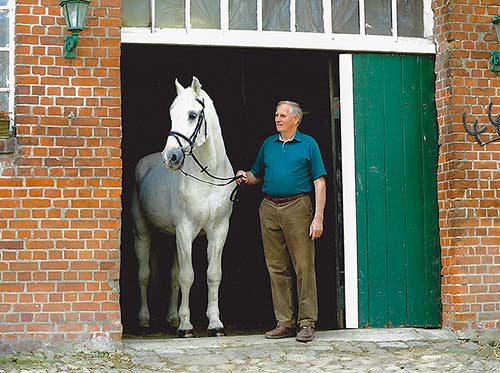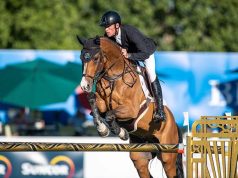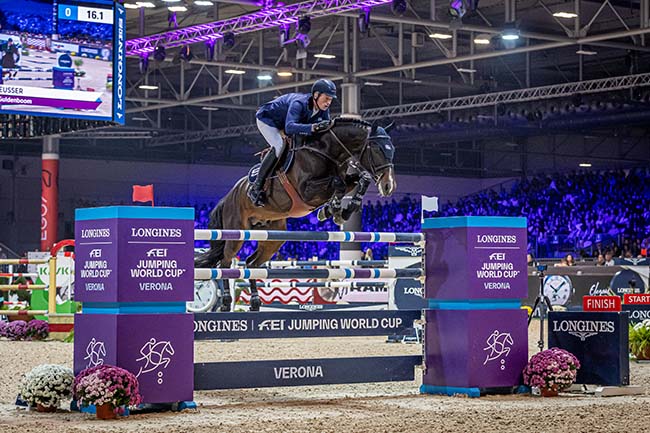
By Adriana van Tilburg
Photography: Peter Llewellyn and private collection
Although 1945 is best known as the year that marked the end of World War II, there is a sense of irony in sport horse breeding when one acknowledges that it’s also the year when some of the greatest modern-day horsmen were born: Paul Schockemöhle, Wiepke van de Lageweg, and Harm Thormählen.
The story of Harm Thormählen is very special. Horses like Rappel, Retina and Gera have significantly contributed to sport horse breeding worldwide. So, how does Harm Thormählen look back upon almost eight decades of being involved in breeding and sport? Already, as a young boy, he was raised among the best horses of the day because his father was a renowned horse dealer.
Q How was it for your father to start his business immediately after World War II?
My father rode before the war in the Hamburg Derby. He was a 1m50-level rider, and was already dealing in sport horses before the war. After the war he continued with this business. For me this was normal because I was raised in this environment. Later, my boss, Alwin Schockemöhle, told me that my father was one the best international horse dealers of his day. I was already 23 at that point and started to reflect on everything that happened at our farm.
I wanted to start riding when I was six and I took riding lessons from Martin Thormählen, who was no relative of ours. He bred Farn (Fax I - Dorette x Monarch, Stamm 18B1). Anyway, he wasn’t at all friendly with me and I had enough of it. I jumped off the horse and ran home crying. I didn’t go to the stables for a long time.
When I was 10 years old we had the famous mare Rappel (Heinzelmann -Kandare x Lorbeer, Stamm 173) who was born in 1939, and I started to ride her. In our first show I won the 1m10 class and finished third in the 1m20 class, so won a bit money. I was now enjoying riding. I also went out riding with a neighbourhood friend. When my father was in a pub doing business, a pony came into the pub and drank beer, so my father bought this pony for me,too.
With Rappel my riding career really started and I became successful. At 14 I qualified for the German young-rider championship by placing in the top three in a 1m30 class. I earned that result at a show in Dithmarschen where I rode against riders who were already competing internationally. Two years later, at 16, I rode in the German young rider championship.

My father bought a Trakehner mare (Luna by Totilas - Loni x Lachteufel) for that, but unfortunately she was in heat at the time, so we covered her. The following year, after I again reached the final, she was already in foal by quite a few onths, and halfway around the course she stopped jumping. She was protecting herself and the foal. This mare is the beginning of the branch of Clinton (Corrado I).
I remember when I was around 10 or 12 years old, my father talking to a client from Switzerland in the stallion station (now 360 years old), standing beside the part of a wall that hadn’t burned down in a fire that happened a long time earlier, that there was no other area in the world that had produced so many international showjumpers. I didn’t know that at that time, but I kept it in mind.
If we look more closely, we can see that 800 meters down the road is where the great-aunt of Retina was born – Bianka (Tobias - Sanna x Ortwin, Stamm 104A, bred by Hermann Bahlmann) who won the Aachen Grand Prix as a six year old in 1934 ridden by A. Holst. And, around the corner, Retina (Ramzes X - Dolli x Lopshorn, Stamm 104A, bred by Hilda Magens) herself was born. She was the youngest Hamburg Derby champion (seven years old, under the saddle of Fritz Thiedemann). Hans Günther Winkler’s first world champion was Orient (Heino-Nenndorf, bred by Claus Thormählen, not related) was also born around the corner here. Ramiro (Raimond - Valine x Cottage Son xx, Stamm 776, bred by Paul Bahlmann) was bred in this area, and his mother was sold in foal to Baron von Nagel.
The horses were developed by working on the hard soil around here, they had to be tough, and the farmers got rid of the horses that didn’t want to work. It was the strength of my father to sell horses, but when the horses got an injury or older he tried to buy them back like he did with several mares: Contiane (damline Corrado I), the full sister (Vase) of Romanus who was twice the most earning jumping horse, he purchased the elite under the horses. Breeding was his hobby, he didn’t need to make money with that. It became our foundation in breeding, buying back these sport horses. With this we also became an important part of the Holsteiner foundation in breeding. Cor de la Bryère came to Schleswig-Holstein thanks to the management of Alwin Schockemöhle and my father, then Maas J. Hell and a commission of the Holsteiner Verband closed the deal.
When I was 13 Princess Margaret came here with her first husband to look for horses. One year later I took six horses by train to Milan, who had already all jumped 1m40. Every 14 days we rode six horses to the train station where they were shipped to South Germany, Switzerland, and Italy.
The better times came for sport horses in the end of the 1950s and 1960 – when the Olympic Games were held in Rome. The top Olympic horses cost around DM100,000 at that time (less then US$25,000 using an historic conversion).
As a young boy I always went to the horse show in Elmshorn. It was unbelievable how many people came to watch. Horse shows were at that time one of the few events people could attend. I also remember how difficult and hard the jumps were for the horses. It was very different then than now, also the way of riding has improved a lot.
I owe Rappel a lot of thanks because it was due to her that I returned to horses, and she is the great-grandmother of Capitol I... To read the complete article you need to be a subscriber
CLICK HERE TO SUBSCRIBE TO BREEDING NEWS
SUBSCRIBERS CAN READ THE COMPLETE ARTICLE BY LOGGING IN AND RETURNING TO THIS PAGE



